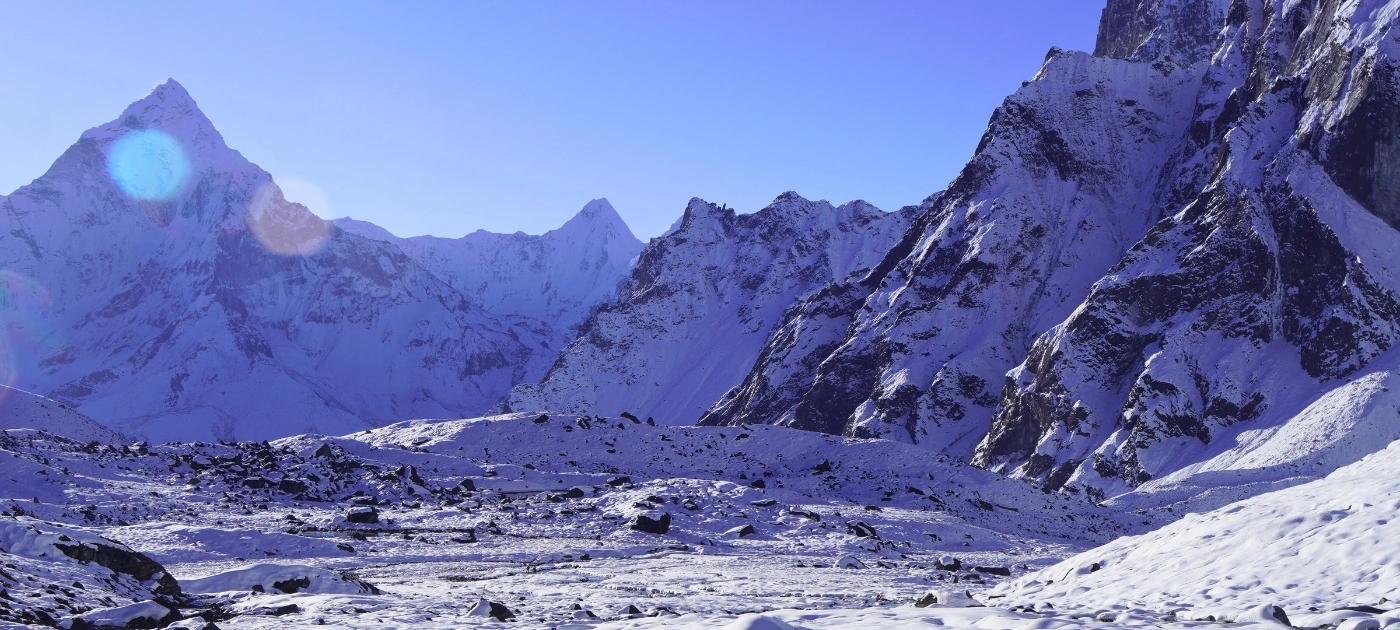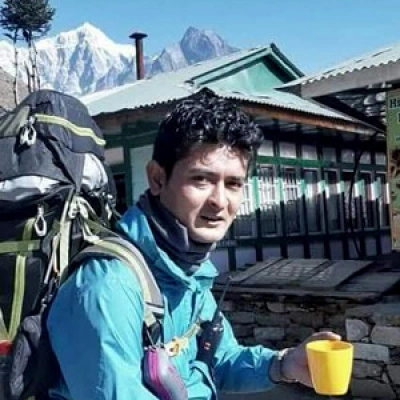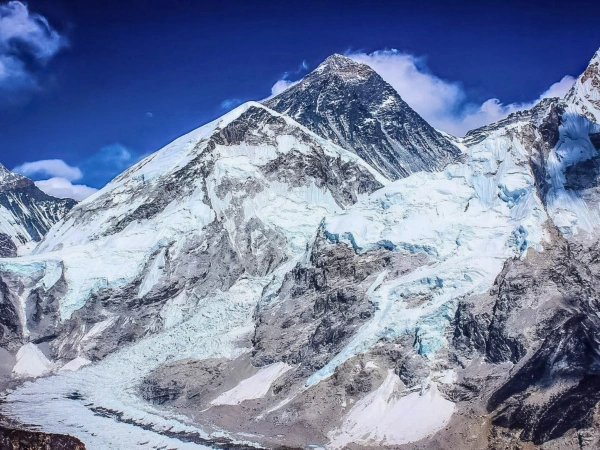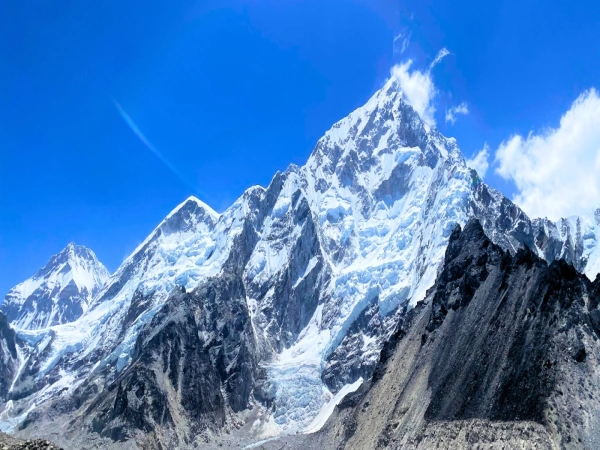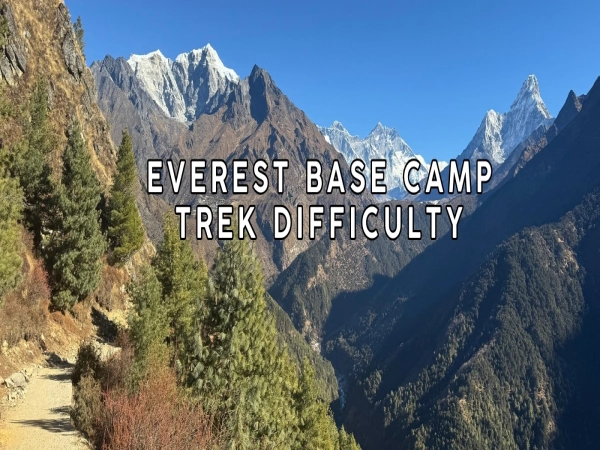Trekking Everest Base Camp (EBC) in January means extreme cold, especially at night (down to -20°C / -4°F), but offers stunning, crystal-clear views with fewer crowds, snow-covered landscapes, and quiet trails, making it a beautiful but challenging winter adventure requiring serious layering, proper gear (warm sleeping bags, insulated boots), and a flexible itinerary to handle potential snow delays. Days are sunny and surprisingly pleasant, but mornings and evenings are frigid, demanding excellent preparation and an experienced guide.
Everest Base Camp Trek in January
Everest Base Camp trek is a journey of dreamers who dream to see a world beyond the clouds. When you choose Everest Base Camp trek in January, you choose the winter. Winter is a less explored season in the Everest. To the daring trekkers, the freezing winter weather is a package full of thrilling excitements.
During January, the route is less trodden. Tiny shrunken faces with curious eyes of red-cheeked Sherpa children are soul warming. The spiritual chants of the Buddhist Monasteries feel so alive.
EBC trek during January takes you through challenging landscapes. Dense layers of snow cover the Himalayan trails. Pumori, Lhotse, Lobuche, Island Peak, Makalu and breathtaking Everest itself are the major attractions.
You will have much fun trekking during this time, but we recommend you to trek with a licensed guide or porter. You may miss the trails in snow or in bad weather so, we recommend you not to opt for Everest region treks in January.
For Map: Everest Base Camp Trek Map
Highlights of Everest Base Camp Trek in January
- A thrilling flight to the Lukla airport
- An amazing view of snow-shaded Everest
- The joyful hospitality of Himalayan Sherpas
- Culture and lifestyles of the locals
- Panoramic views of the snow shed mountains
- The sunrise view in the morning at Kala Patthar (5,643 m)
- The ancient Buddhist Monasteries
- Sagarmatha National Park covered in snow
- Adventurous trek routes
Everest Base Camp: Temperature and Weather in January
January is the winter season in Nepal. It is the coldest month. So, Everest Base Camp trek in January is colder than in spring and autumn.
During January, the Everest region dips in the snow. Temperatures drop below freezing at night. The daytime is quite sunny. In a clear and cloudless day, you will feel warm while trekking.
Weather
The winter weather is at its extreme in January. The time of snowfall begins in the mid of December. Snow covers the region till February.
Wind chill is severe in January. The upper-atmosphere wind entering from the Northern hemisphere dominates the Everest region. The high winds bring colder temperatures and heavy snowfalls as well.
There are a few sunny and clear days. You will experience a stable and dry weather in such days. Yet, the poor visibility due to foggy and cloudy weather can be a problem sometimes.
Temperature
The daytime temperatures in the Everest Base Camp region reaches a largest of 4°C in January. The smallest temperature drops down to around -17°C during the nights.
The altitudes above 4500 meters are colder. The average temperature in this region is between −5 to −12 °C at night and evening before sunrise. Expect temperatures as cold as -30°C at night at higher elevations.
Average Sunshine per Day
The sun shines for an average of 5-7 hours per day in January. You will feel warm and comfortable while the sun shines upon your head. The temperature during the day rises up a little bit after sunrise.
Wind
The daily wind speed in January is about 8-12 mph in general. It is quite windy. So, you will experience the cooling effect of blowing wind.
Note: The weather of the mountains is quite unpredictable. You may have to face different weather conditions in a single day. So, as you leave for this trek you must be physically and mentally ready to face any weather changes that may follow.
Are you planning your Everest Base Camp Trek? Don't hesitate to contact us. Tell us your requirements, we can help you to make your trip memorable.
What to expect during everest base camp trek in January?
Expect stunning, clear mountain views but also extreme cold, especially at night (dropping to -15°C to -20°C or lower), requiring serious winter gear, layered clothing, and a warm sleeping bag. Trails will be snowy and icy, making trekking challenging, demanding an experienced guide, and necessitating contingency days for potential Lukla flight delays or weather changes like occasional blizzards. While daytime sun offers some warmth, early mornings and nights are frigid, with fewer closed teahouses, so book ahead and start trekking early.
Weather & Temperatures (January)
- Daytime: Bright, sunny, but cool (around 0°C to 4°C/32-39°F), with the sun feeling warm.
- Nighttime: Exceptionally cold, dropping to -10°C to -20°C (14°F to -4°F) or colder at higher elevations.
- Air Quality: Crisp, clear, excellent visibility for photos.
- Snow: Regular snowfall, covering trails, but heavy snow usually doesn't last long.
Trail Conditions & Challenges
- Snow & Ice: Expect slippery, snowy, and icy paths, especially at higher altitudes (Lobuche, Gorak Shep).
- Short Daylight: Shorter days mean starting hikes early to maximize walking time.
- Wind: Strong winds can make the cold feel much harsher (wind chill).
- Lukla Flights: High risk of delays or cancellations due to winter fog/wind.
What to Prepare For
- Gear: High-quality down jacket, warm base layers, gloves/mittens, warm hat/balaclava, insulated sleeping bag.
- Flexibility: Build 2-3 extra days into your itinerary for weather delays.
- Guide: Highly recommended for navigating tricky snowy trails and safety.
- Teahouses: Some may be closed; book in advance and be aware of limited options.
- Hydration: Essential, despite the cold, to prevent altitude sickness.
The Upside
- Spectacular Views: Unbeatable clarity of Everest and surrounding peaks under blue skies.
- Fewer Crowds: A more peaceful, intimate trekking experience.
- Cultural Immersion: Deeper connections with locals due to fewer tourists.
Everest Base Camp Trek In January: Is it Possible?
Pack enough warm clothes to withstand the chilling cold of Himalayas. Be determined to fight any difficulty that might come your way. Now, you’re ready to go for Everest Base Camp trek in January.
The daytime offers clear weather and great snow-covered Mountain panorama. January is the driest month in Nepal. So, it is the clearest month for some stunning views high up in the peak of the world. But, it can be foggy in some places at the lower altitudes.
Very few trekkers who don’t care about cold visit the Everest Base Camp in January. The cold may harm you. Be sure that you carry very good equipment against the cold.
Be prepared for a weather change when in the Himalayas. The weather can change unexpectedly. Do not miss to keep an eye on any major cloud build up. No cloud means lesser chances of snow. Piling heavy clouds means a big risk of snow.
If January is your only free month, it is possible to trek to the Everest Base Camp. But before you go, you will need a proper guidance and preparation. Don’t hesitate to ask us for advice or a guide.
Accommodation and Food
In the Everest Region, the lodges and the tea houses open year round. But unlike in the peak seasons, there are only a few cooks & staffs during January.
Food
During January, there are few trekkers in the Everest Base Camp than in main seasons. The weather in January is coldest in the year. Lodge and tea houses are open.
There are lesser options in the food menus. Yet, kitchens are happy to provide you with foods at a lower price than in peak seasons.
They heat water over the stoves and in the kitchens in the lodges. There will be no problems getting hot water, but they will charge for it. Be sure to carry hot water bottles for ease.
Accommodation
Most of the teahouses and lodges are open except for few. Because of the fewer number of trekkers, you will have no difficulties in finding places to stay.
The nights are the coldest. The mattress gets even colder. But, you can demand an extra mat on top of the lodge provided mattress. They have plenty of mattresses.
In many lodges, air leaks from poorly fitted windows. So, the temperature in your room gets even colder. So, try to avoid leaky rooms. You can examine the air leaks before you decide to take the room.
Plus, it is always wise to carry a four-season sleeping bag so that you can warm yourself up wherever you plan to stay.
WhyEverest Base Camp Trek in January?
- To experience a perfect winter world. If you are a winter lover, the Everest Base Camp route makes a flawless winter world. The majestic Himalayan peaks emerge in the snow. The settlements in the higher altitudes crown with snow. The view of nature ornamented in a clean snow white is alluring.
- To capture the unbelievable beauty of the Everest region in winter. Visit Everest Base Camp In January for best winter photography. The stunning Himalayas pose for you. The beautiful Valleys, Glaciers and the. The afternoon is a suitable time for photography. Catching the sunset and sunrise views in the backdrop of snow-blanketed surrounding will soothe your soul.
- To explore the winter life of Native Himalayan Sherpas. Sherpas are the dwellers of the footprint of the world’s highest peak, Mount Everest. The life of Himalayan Sherpas is inspiring. Accommodation in such a weather and climate is tough. January is the best time to explore the life of Himalayan Sherpas in winter.
- To experience the warm and pleasing hospitality of locals. The hospitality of the Sherpas is heartwarming. You will experience the homely environment and their pleasing hospitality. The chilling winter effect reduces with their warm greeting and smiles.
- To view the best sceneries. Places like Kala Patthar, Khumbu Glacier, Tengboche monastery, Namche Bazaar, and Khumjung have the best scenarios in the world. And in January they are too crisp. Winter adds beauty to the Himalayas.
- Less crowded and much quieter trails. The Everest Base Camp route is less explored during January. Winter is at its extreme. So, there are very few travelers who dare to trek this region in January. So, the trial is peaceful and quiet. You will have enough of the route for yourself without worries of others disturbing you.
Pros of Trekking to Everest Base Camp in January 2026
Trekking Everest Base Camp (EBC) in January offers stunning, clear mountain views, peaceful, less crowded trails, easier Lukla flights, potential discounts, and the magical sight of snow-covered landscapes, ideal for photographers; however, be prepared for extreme cold, shorter daylight, and potentially closed high-altitude teahouses, requiring proper gear and a guide for safety.
Stunning Scenery & Clear Skies
- Unobstructed Views: January's cold, dry air brings crystal-clear skies, providing breathtaking panoramic views of Everest, Lhotse, and Ama Dablam from vantage points like Kala Patthar.
- Snow-Covered Beauty: The entire landscape, including peaks, valleys, and frozen lakes, is dusted in snow, creating a picturesque, "heavenly" environment perfect for photography.
Peaceful & Quiet Experience
- Fewer Tourists: As an off-season, trails are quiet, allowing for a tranquil experience, solitude, and a deeper connection with the mountains, unlike the busy peak seasons.
- Easier Flights: Fewer trekkers mean easier, often cheaper, flights to Lukla, with less chance of weather-related delays.
Cost Savings & Accessibility
- Discounts: Lower tourist numbers often lead to package deals, discounted prices, and better deals on accommodation and services.
- Accessible Teahouses: While some high-altitude ones close, open teahouses might offer better rooms at lower prices.
Unique Experiences
- Festive Cheer: You might even get to celebrate the New Year with locals, adding a cultural highlight.
- Photography Goldmine: The sharp light, blue skies, and pristine snow make it a dream month for photographers.
Considerations (Cons)
- Extreme Cold: Nights are freezing, requiring serious winter gear and layers.
- Shorter Days: Less daylight means you need to plan treks carefully.
- Closed Routes/Lodges: Some higher-altitude teahouses shut down, and snow can block certain trails, making a guide essential.
Tips to Trek Everest Base Camp in January
The most important thing to consider while trekking to the Everest Base Camp in January is the cold. Here we give you some tips so that you will have much easy time trekking in the Everest region.
- Protect yourself from the cold. The Everest region is the coldest in January. The cold Himalayas could engulf you. You may get severe sickness due to cold. So, carry accessories to help yourself against the cold.
- Carry the best pair of shoes for walking on snow. Walking on snow/ice in normal shoes is impossible. So, choose the shoes with grippy soles. Also, the shoes should be waterproof.
- Be sure to watch for the bad weather. Bad weather may take over the surroundings anytime in the Himalayas. In January, you’ll see the most variable and tough weather. So, always watch for the clouds to assume the weather.
- Pack your bag with ‘WARM’ accessories. Chilling cold is your enemy while trekking to the Everest Base camp in January. To prevent yourself from getting caught by the cold, make sure you carry enough warm clothes, boots & sleeping bag. Remember to pack warm caps, gloves, and socks.
- Carry medicines against cold. You may get sicknesses due to extreme cold. Carry medicines and first aid with you. Include cough syrup, anti-cold tablets, and inhalers. They will help you with nasal clogging due to colds.
- Manage accommodation and food before you go. Since January is a very less explored season in the Everest Base Camp, many teahouses may remain closed. It is impossible to trek without a suitable place for accommodation and food in the mid of winter.
- Follow the advice of a destination expert. Trek with a partner. You cannot take a risk of disappearing in the Himalayas while trekking. So, we recommend you to trek with an experienced guide. They have a good approximation of weather change and the trekking paths.
- Carry a warm sleeping bag. In cold conditions, evaporation from your body may freeze on the top of the sleeping bag. A thick bag is more difficult to dry out. Carry an easy warm bag.
Difficulties during Everest Base Camp Trek in January
Everest Base Camp trek in January is less recommended. But you can go if viewing Everest and its extreme beauty in winter is your dream. However, you will have to go through various difficulties during the trek.
- Shorter days. The days are shorter. So, you might have difficulties in keeping track of time. Also, the number of trekking hours per day is less.
- Difficulties due to piles of deep snow. The trails in the upper regions fade in the snow. In some places, you will have to walk through the snow covering your waist.
- Cold freezing temperature. January is one of the coldest months in the Everest region. The temperature is below freezing point. There are chances that you get frostbite if you are not cautious.
- Chances of losing the track of paths. The trails are dense piles of white snow. You cannot see any distinct tracks. So, there are chances that you might lose the track of paths.
- Boots freezing at night. The temperature at the lodges is freezing. Wet sleeping bags and icy boots at nights are amongst the difficulties faced by most of the trekkers.
- Hurricane force winds and wind chill. The biggest issues faced by the climbers are the fierce wind blows in the region. The chilling wind may bring bad weather to the Everest region.
Are you planning your Everest Base Camp Trek? Don't hesitate to contact us. Tell us your requirements, we can help you to make your trip memorable.
Packaging lists for Everest Base Camp Trek in January
- A good quality sleeping bag
- Fleece Wind-stopper Jacket (Waterproof)
- Thermals
- Warm Shirts
- Undergarments
- Warm and waterproof Pants
- Warm Trousers
- Hot Water Bottle (with no leaks)
- Woolen caps
- Woolen scarf
- Sunglasses
- Hiking socks(warm)
- Boots with grippy soles
- Camp shoes (Sneakers)
- Woolen Gloves ( warm)
- Rucksack Bag with a waterproof shell
- Basic First Aid Kit (Include cough syrups and anti-cold medicines)
- Water Bottles
- Guide Book with a Trail map
- Binoculars
- Toothbrush and Toothpaste
- Moisturizer, Sunscreen Creams
Conclusion
Everest Base Camp trek in January is one of the hardest, yet most rewarding trek. If you wish to explore the peaceful snow-filled world of the Everest, you can go for the Everest Base Camp trek in winter.
During January, the weather and climatic conditions may turn hazardous. Always keep in mind some of the basic measures of caution. Plus, walk determined with proper packing, then you will safely trek to the Everest Base Camp.
Are you planning your Everest Base Camp Trek in New Year 2026? Don't hesitate to contact us. Tell us your requirements, we can help you to make your trip memorable.
